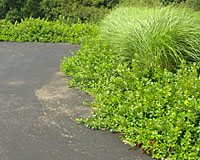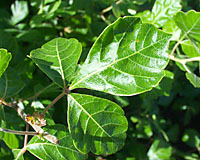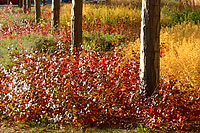Terry L. Ettinger Horticulture Consulting Services
Meeting The Needs Of Today With A Vision For The Future
Recommended Groundcovers -
'Gro-low' Fragrant Sumac
 I was introduced to `Gro-Low' fragrant sumac (Rhus aromatica `Gro-Low'), a rugged, low-growing native shrub that's edging the
driveway in the picture at right, while working as a propagator for a large nursery outside of Chicago the year after graduating from
college. Over the course of several hot, sultry days in the middle of July, my crew and I collected tens of thousands, eight to ten
inch-long softwood cuttings of this plant from locations scattered throughout the western suburbs of Chicago.
I was introduced to `Gro-Low' fragrant sumac (Rhus aromatica `Gro-Low'), a rugged, low-growing native shrub that's edging the
driveway in the picture at right, while working as a propagator for a large nursery outside of Chicago the year after graduating from
college. Over the course of several hot, sultry days in the middle of July, my crew and I collected tens of thousands, eight to ten
inch-long softwood cuttings of this plant from locations scattered throughout the western suburbs of Chicago.
 Introduced
by Synnesvedt Nursery of Glenville, Illinois, this ground-covering
shrub has been planted
by the hundreds, and sometimes by the thousands, in office parks and
along highways throughout the Midwest for decades because if its
ease of establishment, fast growth, and durability.
Introduced
by Synnesvedt Nursery of Glenville, Illinois, this ground-covering
shrub has been planted
by the hundreds, and sometimes by the thousands, in office parks and
along highways throughout the Midwest for decades because if its
ease of establishment, fast growth, and durability.
 Its shiny, mint-green, pest-resistant leaves, above left, aren't
affected by intense summer drought, heat and humidity that's
common throughout the Midwest. In fact, the hotter, drier and
sunnier the site, the better this plant tends to grow! Then, in
October, it's leaves turn brilliant reddish-orange, at right, to
scarlet, below left.
Its shiny, mint-green, pest-resistant leaves, above left, aren't
affected by intense summer drought, heat and humidity that's
common throughout the Midwest. In fact, the hotter, drier and
sunnier the site, the better this plant tends to grow! Then, in
October, it's leaves turn brilliant reddish-orange, at right, to
scarlet, below left.
Once established, this shrub can put on the better part of a foot of growth a year - ultimately reaching a mature size of two to three feet tall by eight to ten feet wide. And, to put your mind at ease, this plant is not a rampant invader like Staghorn sumac (Rhus typhina).
 Because
its flowers and fruit are of
little ornamental value, this plant is best used in masses on steep
slopes and/or along driveways, streets and roads - places where its
always difficult to maintain a nice lawn because of dry soils, road
salt and damage from snowplows.
Because
its flowers and fruit are of
little ornamental value, this plant is best used in masses on steep
slopes and/or along driveways, streets and roads - places where its
always difficult to maintain a nice lawn because of dry soils, road
salt and damage from snowplows.
If it does get crushed by deep piles of snow, or broken down by a snow plow, simply shear or mow it back to three inches from the ground - and don't bother trying to pick up the clippings. By mid-summer, the damaged plants will have completely recovered after putting out a new flush of growth!
 In these settings, combine masses of this plant with others having
bright yellow (`Frau Dagmar Hastrup' rugosa rose,
bluestars, etc.) or gray-green
fall foliage (catmint) that tolerate similar conditions for an
eye-catching tapestry of color and texture!
In these settings, combine masses of this plant with others having
bright yellow (`Frau Dagmar Hastrup' rugosa rose,
bluestars, etc.) or gray-green
fall foliage (catmint) that tolerate similar conditions for an
eye-catching tapestry of color and texture!